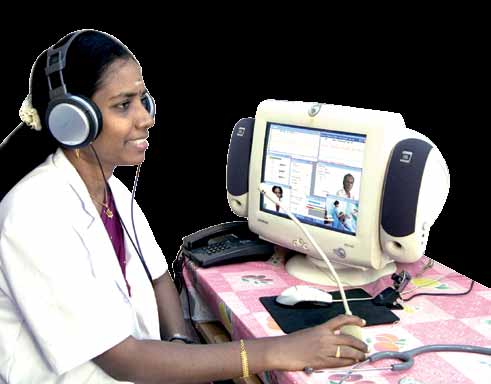JULY 2010: Farveen lives in a remote area of Andhra Pradesh’s Kurnool district. When a scorpion bit her friend last year, she was clueless about the first aid required. She immediately called 104 Advice helpline of the Health Management Research Institute (HMRI). The practitioners SMSed her the prescription, along with first aid instructions. Thanks to telemedicine, Farveen was able to save her friend.

Had the situation required detailed diagnosis, the ‘Doc-in-the-Box’ would have come to Farveen’s aid. HMRI’s telemedicine solution looks like a pizza delivery bike, but is a virtual hospital! It uses a combination of medical equipment, communication technologies and software to provide rural patients with access to low-cost yet world-class medical diagnosis and treatment. They do this using virtual physical examination and consultation modules such as tele-ENT, tele dermatology, tele-medical and surgical consultation, tele-cardiology and tele-ophthalmology.
Piloted in Andhra Pradesh, HMRI has deployed its telemedicine technology to provide a primary healthcare physician’s treatment at several old-age homes, as well as specialised cardiology consultation at district hospitals. In a little over a year, it has provided tele-consultation to over 15,000 patients. No wonder, HMRI has been chosen as a ‘social innovator’ by NASSCOM.
More success stories
A few years ago, when Sameer Sawarkar and Rajeev Kumar realised that 80 per cent of India’s healthcare professionals are in urban areas while 70 per cent of the population resides in the rural segment, they decided to bridge this cleft using technology. After all, not every villager can afford to travel to the nearest township to consult a general physician, let alone a specialist. So they decided to take the water to the horse rather than dragging the horse to the pond, and started Neurosynaptic Communications, in close association with IIT-Madras’ TeNeT Group.
[stextbox id=”info” caption=”Telemedicine At A Glance”]
Telemedicine can be broadly defined as healthcare services delivered through telecommunication networks. In simplest terms, telemedicine can be explained as two doctors or doctor-patient discussing the case on a phone. Practiced telemedicine is more than simple voice communication over telephone lines. It is the integration of store-and-forward technology with real-time responses.
Telemedicine is the only solution to provide healthcare services to people in remote locations. Conventionally, the government would need to build hospitals in every village and provide physicians to each, which is an extremely daunting task. Alternatively, we could use IT tools like telemedicine to provide quality healthcare to all.
Technical components of a typical telemedicine system
1. Data acquisition (the capability to integrate with medical equipment and acquire data)
2. Electronic record management (includes patient registration details, history, prescription, lab reports, etc) 3. Video and image conferencing
4. Communication networks (broadband, mobile, etc) for data transfer between remote locations and expert centres
Non-technical components
1. The patient
2. A doctor situated at the remote location who decides the need for telemedicine and links up with the expert for consultation through the telemedicine system
3. A technical operator who handles the telemedicine system, voice or video-based conferencing, report transmission, prescription receipt, print-outs, etc
4. An expert who caters to the telemedicine request from a main centre
Benefits of telemedicine
1. Healthcare services delivered at your doorstep. In urban areas, this means avoiding the traffic. In rural areas, it means the boon of healthcare. The same can be true for second opinions, lab reports, radiology reports, etc.
2. Telemedicine components like Web-based patient health records can be very useful in the case of emergencies.
3. Patient health records prove to be a lifetime medical history and can be used for health monitoring. Prompt reminders for health checkups may prevent many issues.
4. In the case of chronic cases, repeated hospital visits can be prevented.
5. Improved reach to rural areas.
6. Can even be used for healthcare education.
—By Devendra Patel, director, Medisoft Telemedicine
[/stextbox]







good visions